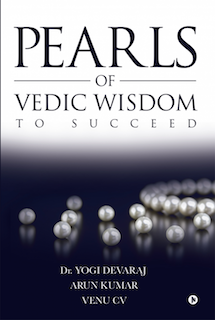Sadhana means “Effort”.
Guru shows the pupil the path of Sadhana (effort). The Vedic literature explains the Sadhana in detail and shows us how to make the effort. It is called Sadhana Chatushtaya, the four-fold qualifications that need to be acquired after constant and intense practice.
After that one should do Shravana (hearing / reading), Manana (understanding, reflecting upon, clarifying doubts) and finally Nididhyasana (meditation / contemplation / single pointed concentration on Atman, the Self).
Sadhana Chatushtaya, the four-fold qualifications show us that first we should develop Viveka (reasoning) so that we clearly do the planning and understand what we are aspiring for. Whatever be the goal, Viveka helps us understand the task at hand and do the meticulous planning to reach the goal. Vairagya (dispassion) is to develop disinterest and disgust towards all the things that are not helpful and are distractions that impede our progress towards the goal. Shad Sampat is the six-fold treasures, the virtuous qualities that help strengthen the will and determination and propel us towards the goal. Finally, the Mumukshutva is the burning desire, the earnest yearning to attain the goal.
Chaturvidha Purusharthas, the four objects of human pursuit, Dharma (righteousness), Artha (wealth), Kama (desire) and Moksha (emancipation) teach us to live righteously without compromising them, pursue one’s ambition as per one’s capability and earn as much as possible and from the money earned, fulfil all the needs, desires, comforts and luxuries, and finally realise the fleeting temporariness of all the materialist things and pursuits.
Karma Theory highly encourages the value-based living and basically advocates “what goes around comes around”. Belief in Karma Theory promotes Universal Brotherhood, harmonious coexistence and civilised living.
Triguna (three qualities) helps us understand the three Gunas (qualities), Sattva, Rajas and Tamas. Tamas signifies laziness and lethargy. Rajas signifies hyperactivity and restlessness. Sattva signifies calmness, peace, happiness and contentment. The objective is to increase the Sattva and ensure that Sattva is more predominant in our personality so that we can radiate happiness all around.
After practicing these ideals, one may learn more from the same Guru or different Gurus and the effort and practice should be intensified. It is just like a professional sportsperson has many different coaches in the career and keeps improving the skills by trying to always learn something new and intensifying the efforts.
Jnana Marga (Path of Knowledge) encourages one to understand the concepts clearly before putting in the required effort to attain the goal. Advaita Vedanta encourages one to have in-depth and profound knowledge in any field of choice. Knowledge in any field such as Mathematics, Physics, etc. including the study of the Vedic scriptures is called Apara Vidya (material or lower knowledge) by Mundaka Upanishad (1.4 – 1.5). Only after possessing in-depth knowledge and excelling in Apara Vidya one becomes eligible to succeed in attaining the Para Vidya (real or higher knowledge) which is succeeding in dropping the ego and being in Silent Awareness and it is called Self-Realisation.
Once the Sadhana (effort) is intense, the knowledge and practice of Sadhana Chatushtaya is complete then it is the completion of Apara Vidya. When a sincere seeker becomes an expert in Apara Vidya, the intellect is sharpened and the instrument which is the intellect becomes eligible and fit enough to gain and grasp the Para Vidya which is Self-Realisation, the ultimate goal of Advaita Vedanta.
See Also:


Post a Comment
Post a Comment